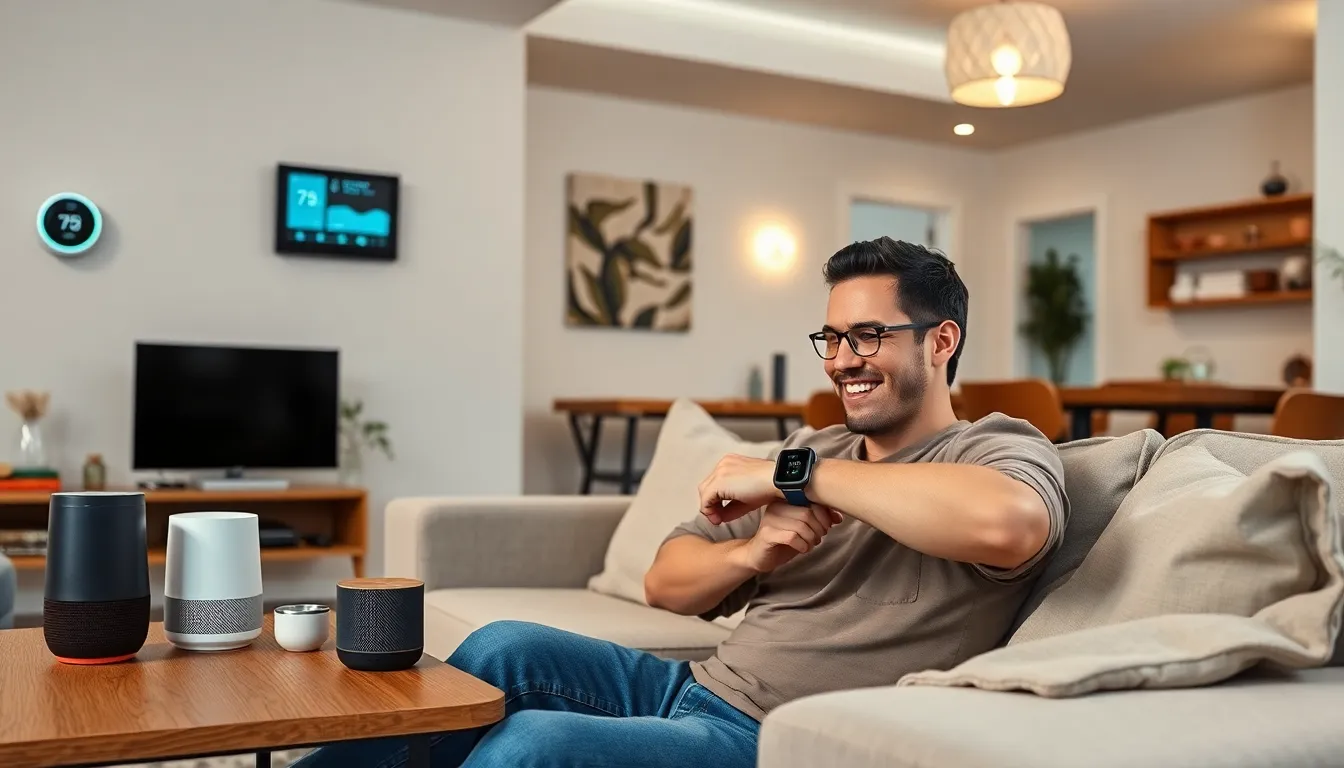Smart devices have revolutionized the way people interact with technology in their daily lives. From smartphones to smart thermostats, these gadgets seamlessly integrate into homes and routines, enhancing convenience and efficiency. As technology advances, the capabilities of smart devices continue to expand, making them indispensable tools for modern living.
With the rise of the Internet of Things (IoT), smart devices are now more interconnected than ever. They communicate with each other, allowing users to control everything from lighting to security systems with just a few taps on their screens. This integration not only simplifies tasks but also provides valuable data that can improve decision-making and energy management. Embracing these innovations opens up a world of possibilities for both individuals and businesses alike.
Table of Contents
ToggleOverview of Smart Devices
Smart devices are electronic gadgets equipped with internet connectivity and advanced functionalities. These devices communicate with each other through the Internet of Things (IoT), creating a network that streamlines everyday tasks. Smart devices include smart speakers, thermostats, security cameras, and lights.
Smart speakers, like Amazon Echo and Google Home, offer voice-activated assistance. Users can play music, control smart home devices, and access information hands-free. Smart thermostats, such as the Nest Learning Thermostat, learn user preferences and optimize heating and cooling for energy efficiency.
Smart security cameras enable remote monitoring of properties. With features like motion detection and night vision, these cameras provide real-time alerts to users on their smartphones. Smart lights, including Philips Hue, can be controlled remotely, allowing users to adjust brightness and color through apps.
The integration of these devices enhance home automation and data-driven decision-making. By collecting usage data, smart devices help users manage energy consumption effectively. They also promote safety and convenience, making them integral to modern lifestyles.
Types of Smart Devices

Smart devices fall into several categories, each serving unique functions that enhance user experience and convenience. Two prominent types are smart home devices and wearable smart devices.
Smart Home Devices
Smart home devices automate and control household functions through internet connectivity. Common examples include:
- Smart Speakers: Devices like Amazon Echo and Google Home provide voice-activated assistance, allowing users to control music, set reminders, and manage compatible smart devices.
- Smart Thermostats: Products such as the Nest Learning Thermostat learn user behaviors to optimize heating and cooling systems, resulting in energy savings.
- Smart Security Cameras: Cameras enable remote monitoring of properties with features like motion detection, offering a secure connection to users’ homes.
- Smart Lights: Systems like Philips Hue allow remote access for brightness and color adjustments, contributing to enhanced ambiance and convenience.
These devices integrate seamlessly, promoting energy management and security within the home environment.
Wearable Smart Devices
Wearable smart devices focus on health monitoring and connectivity. Key examples include:
- Smartwatches: Watches from brands like Apple and Fitbit track fitness metrics, receive notifications, and even monitor heart rates, ensuring users stay connected on the go.
- Fitness Trackers: Devices such as the Garmin Forerunner offer insights into physical activities and health metrics, encouraging a healthier lifestyle.
- Smart Glasses: Products like Google Glass enhance reality by providing information directly within the user’s line of sight, allowing for hands-free interaction.
- Health Monitors: Wearable monitors collect data on vital signs, assisting users in tracking their health and wellness progress.
These devices deliver real-time data and insights, fostering a proactive approach to health and lifestyle management.
Benefits of Using Smart Devices
Smart devices significantly enhance daily life by offering convenience and efficiency. Their capabilities streamline various tasks, making them essential in modern living.
Convenience and Automation
Smart devices provide unmatched convenience through automation. They allow users to control home environments remotely via smartphones or voice commands. Smart speakers, for instance, facilitate hands-free operation for music and information retrieval. Smart thermostats adjust temperatures automatically based on user habits, leading to optimal comfort without manual intervention. Furthermore, smart lights enable users to set schedules or control brightness remotely. This level of automation simplifies daily activities and enhances user experiences.
Improved Efficiency
Efficiency gains arise from integrating smart devices into daily routines. Smart thermostats can reduce energy consumption by learning preferred settings, leading to energy savings up to 10-15% annually. Smart security cameras and systems enhance security management by providing real-time alerts and remote monitoring capabilities. Wearable smart devices like fitness trackers can monitor physical activity, helping users make informed decisions about their health. Collectively, these devices maximize resource management, offering users valuable insights and promoting sustainable living.
Challenges and Concerns
Smart devices offer numerous advantages, but they also present significant challenges and concerns, particularly regarding privacy, security, and compatibility.
Privacy and Security Issues
Privacy and security issues pose major concerns for users of smart devices. These devices often collect personal data to enhance user experience, leading to potential misuse if not properly secured. Hackers can exploit vulnerabilities in smart devices, resulting in unauthorized access to sensitive information, including home security footage and personal health data. According to a report by the Cybersecurity & Infrastructure Security Agency (CISA), over 70% of smart devices have known security flaws. Manufacturers must prioritize robust security measures, including regular firmware updates and encryption protocols, to protect user data effectively.
Compatibility and Interoperability
Compatibility and interoperability challenges arise due to the diverse range of smart devices available in the market. Different manufacturers often use proprietary technologies, making it difficult for devices to communicate seamlessly with one another. For instance, a smart speaker from one brand may not fully integrate with a smart lighting system from another brand. According to a study by the International Data Corporation (IDC), 62% of smart device owners experience issues related to compatibility. Open standards and universal protocols, such as Zigbee and Z-Wave, can help address these concerns by enabling smoother interactions between devices, enhancing user experience.
Future Trends in Smart Devices
Future trends in smart devices emphasize increased integration, enhanced intelligence, and improved user experience. Smart devices will continue evolving, leveraging advancements in artificial intelligence (AI) and machine learning (ML) to offer more personalized and adaptive functionalities.
- Interconnectivity: Devices increasingly interconnect through advanced platforms, enabling seamless communication and control. Users can expect a unified experience across different manufacturers and ecosystems. Increased migration toward protocols like Matter enhances compatibility among various smart home devices, promoting cohesive interoperability.
- Voice Interaction: Voice control becomes more sophisticated, driven by advancements in natural language processing. Devices will interpret more complex commands, facilitating hands-free control of home automation systems. Innovations in voice recognition improve accuracy, making interactions more intuitive.
- Edge Computing: Edge computing will accelerate performance by processing data closer to the user. Smart devices will manage tasks locally, reducing latency and enhancing responsiveness. This minimizes reliance on cloud computing, addressing privacy concerns linked to data transmission.
- Health Monitoring: Wearable devices expand their health monitoring capabilities, incorporating advanced sensors and analytics. New smartwatches and fitness trackers will provide insights on vital signs, sleep quality, and stress levels, fostering a more proactive health management approach.
- Sustainability: Sustainability will influence the development of smart devices. New devices incorporate energy-efficient functionalities and utilize sustainable materials. Manufacturers will prioritize eco-friendly designs to align with growing consumer demand for environmentally responsible products.
- 5G Integration: The rollout of 5G technology will enhance smart devices’ capabilities. Faster data transfer speeds and lower latency will support more connected devices within homes. Users can expect improved streaming, real-time security monitoring, and instant notifications from smart systems.
- AI-Powered Automation: Artificial intelligence will enable smarter automation. Devices will learn users’ routines over time, anticipating needs and adjusting settings automatically. For instance, smart thermostats will optimize energy use further by predicting occupancy patterns.
- Augmented Reality (AR): AR will enter the smart device landscape, transforming user interfaces. Smart glasses and AR-enabled devices will overlay digital information onto the physical world, enhancing interaction with smart home systems and facilitating maintenance tasks.
- Enhanced Security Measures: Security will remain a priority as threats evolve. Manufacturers will implement advanced encryption methods and biometric authentication to protect user data. Regular firmware updates and security patches will help counteract vulnerabilities.
- Smart Cities: The concept of smart cities will shape future smart devices. Urban environments will integrate connected infrastructure, enabling smarter traffic management, waste reduction, and energy distribution. Residents will benefit from enhanced services and increased efficiency in daily activities.
These trends signify a transformative phase for smart devices, positioning them as essential components of modern living, catering to evolving user needs and expectations.
Smart devices are reshaping how people interact with their environments. Their ability to enhance convenience and efficiency makes them indispensable in today’s fast-paced world. As technology continues to evolve the integration of these devices will only deepen, creating smarter homes and healthier lifestyles.
However the challenges of privacy and security must be addressed to ensure user trust and safety. Future innovations promise even greater interconnectivity and intelligence making smart devices more intuitive and responsive to individual needs. Embracing these advancements will lead to a more sustainable and connected future where smart devices play a crucial role in daily life.





